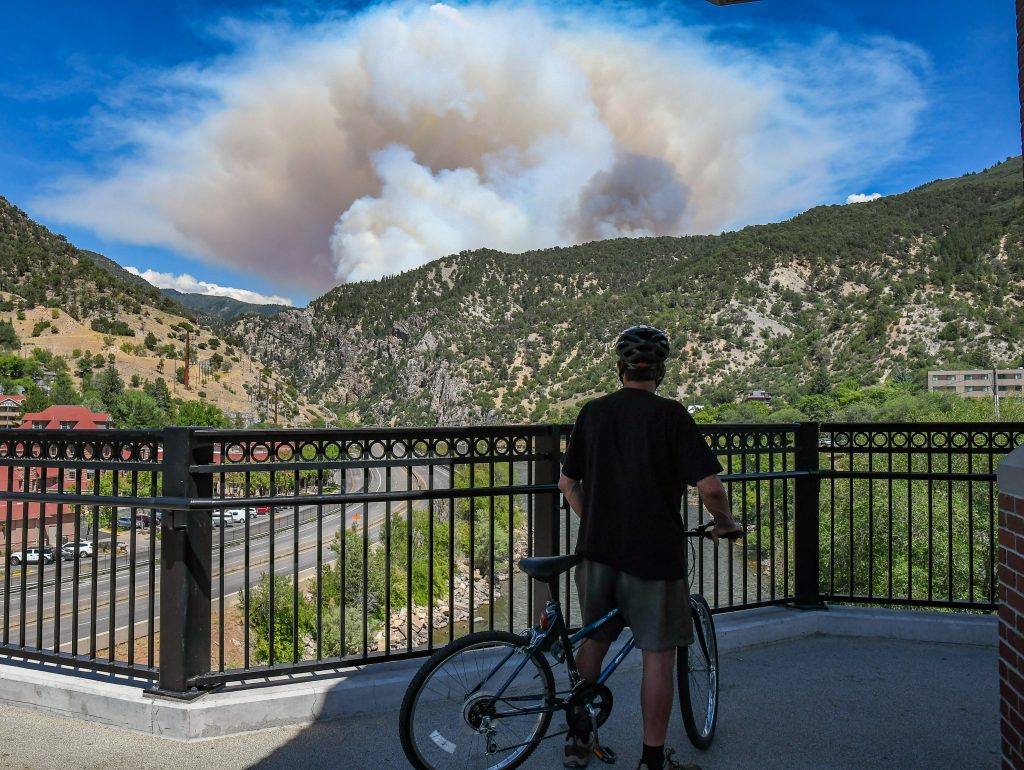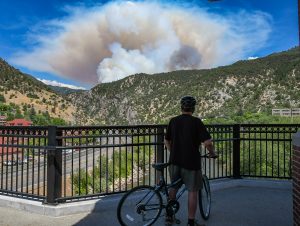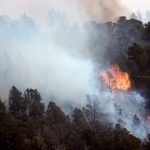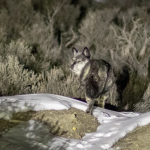Grizzly Creek Fire marks 5 years since largest blaze in White River National Forest

Chelsea Self / Post Independent
Five years ago on Sunday, a wall of smoke erupted along Interstate 70 in Glenwood Canyon, marking the start of the largest wildfire ever recorded in the White River National Forest and one of the most disruptive events in Glenwood Springs history.
The Grizzly Creek Fire ignited at about 1:30 p.m. Aug. 10, 2020, just west of the Grizzly Creek rest area. Fueled by one of the driest summers on record, the fire spread quickly beneath the westbound lanes and raced up the north canyon wall. Within hours, it had crossed the interstate and the Colorado River, forcing the evacuation of rafters, hikers, and residents alike.
“It wasn’t going to be a one-day thing,” said Glenwood Springs Fire Investigator Estevan Sandoval. “It lasted weeks, and we saw what it did to our community. It shut the interstate down. It was the highest-priority fire during that time of year.”
Fire investigators later determined the blaze was human-caused, likely from passing interstate traffic, but no specific source was ever identified. The Grizzly Creek Fire soon became the nation’s top firefighting priority even as dozens of other wildfires burned across much of the West.
The rugged, steep terrain of Glenwood Canyon made ground attack nearly impossible in the early hours of the blaze. With flames spreading in both directions, initial air support was critical — and the canyon quickly became the stage for a multiweek aerial firefight.
“Once crews got on scene, they saw it was well above what we could handle,” Sandoval said. “It was going to be an air show, basically, just because of how fast it moved up the hillside.”

Sandoval wasn’t on shift the day the fire started, but like many off-duty firefighters, he was quickly called in. He spent the following night helping protect the Shoshone Generating Station, a key power source located deep within the canyon.
“We had to camp out there all night and set up water lines around the whole power plant so that it didn’t burn up,” he said. “We were out there from 3 or 4 in the afternoon until about 9 the next morning, just making sure we had water all around it to save it, in case we had to.”
The fire forced evacuations in the No Name neighborhood, populated areas south on Lookout Mountain, Bair Ranch and further east toward Dotsero. Hanging Lake, one of the canyon’s most visited natural landmarks, was evacuated. Although the fire burned sections along trail, Hanging Lake itself was miraculously spared.
Command of the fire was established in Eagle County, where access to the lines was easiest. At its peak, nearly 650 personnel and dozens of aircraft battled the flames under the leadership of the Great Basin Incident Management Team. On Aug. 25, incident command was handed off to the Alaska Type 1 Team, one day after Interstate 70 finally reopened.
The closure lasted two weeks — the longest in the canyon’s history — severing the primary east-west route through Colorado. Traffic was rerouted over U.S. highways 40 and 50, while narrow mountain passes like Cottonwood and Independence were tightly controlled.
“It was a bit scary,” Sandoval said. “Especially as a firefighter, you get there and you’re kind of helpless for some of it. But Mother Nature was on our side. The wind blew it away from Glenwood. We were lucky it didn’t get worse.”
Sandoval said he first saw the plume while driving away from town with his son, Joaquin, who spotted it in the rearview mirror.
“He was like, ‘That’s huge.’ I looked back and pulled off in Silt and could see the plume,” he said. “That’s when we started getting the text messages — all hands on deck.”
The Grizzly Creek Fire eventually consumed 32,631 acres and burned well into the fall. It surpassed the 2018 Lake Christine Fire, which took place near Basalt and Carbondale, and became the most destructive wildfire on Forest Service land surrounding Glenwood Springs. It was officially declared 100% contained on Dec. 18, after seasonal snowfall helped extinguish lingering hotspots.
No structures were lost, and no serious injuries were reported. But the long-term impacts were only beginning.
The fire left behind a vast burn scar through the canyon that had previously been blanketed in dense forest. In the summer of 2021, heavy rains triggered catastrophic debris flows, burying sections of I-70 under tons of mud and rock and stranding motorists overnight. Since then, the Colorado Department of Transportation has invested in flood mitigation and adjusted rainfall thresholds that trigger automatic canyon closures.
For months leading up to the Grizzly Creek Fire, area fire crews had already been busy battling smaller brush fires around Glenwood Springs as well as a massive wildfire to the west. The lightning-caused Pine Gulch Fire near Grand Junction had started just days earlier and would go on to burn more than 139,000 acres. By comparison, Grizzly Creek wasn’t the largest fire in the state that year — but its location made it among the most consequential.
Five years later, Glenwood Canyon is greener again. Hanging Lake is open with an updated and modernized trail. Traffic flows through the canyon, albeit with caution when storms are forecast. Still, the Grizzly Creek Fire remains a turning point for the region — and a reminder of how quickly everything can change.
“It was a big effort from a lot of different departments,” Sandoval said. “Everyone stepped up, and it saved our community.”

Support Local Journalism

Support Local Journalism
Readers around Glenwood Springs and Garfield County make the Post Independent’s work possible. Your financial contribution supports our efforts to deliver quality, locally relevant journalism.
Now more than ever, your support is critical to help us keep our community informed about the evolving coronavirus pandemic and the impact it is having locally. Every contribution, however large or small, will make a difference.
Each donation will be used exclusively for the development and creation of increased news coverage.









